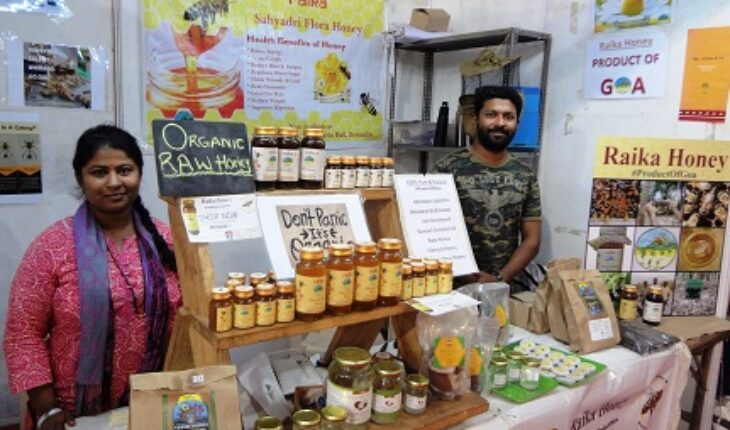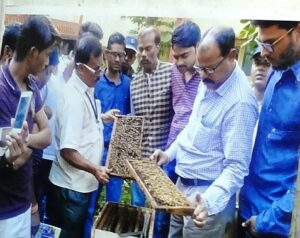 Honey has been associated with wellness and good health over the ages and still continues even today with its uses in various aspects of human lifestyles. But the honey producers – the Bees – numbers are reported to be dwindling with one-third of the bees population reported to have disappeared in the UK during the past decade. While Bees pollinate around one-third of food crops and 90 per cent of wild plants, which in turn provide food for livestock, the implications of this ecological disaster are alarming for biodiversity, the food chain and, ultimately, our ability to feed ourselves.
Honey has been associated with wellness and good health over the ages and still continues even today with its uses in various aspects of human lifestyles. But the honey producers – the Bees – numbers are reported to be dwindling with one-third of the bees population reported to have disappeared in the UK during the past decade. While Bees pollinate around one-third of food crops and 90 per cent of wild plants, which in turn provide food for livestock, the implications of this ecological disaster are alarming for biodiversity, the food chain and, ultimately, our ability to feed ourselves.
The factors leading to decline of bees includes habitat loss, climate change (recent research shows that pollinating insects are particularly sensitive to factors that upset their biological balance), intensive farming methods and colony collapse disorder (CCD) – which occurs when the majority of worker bees in a colony simply ‘disappear due to — scientists believe — the use of a new class of pesticides called ‘neonicotinoids’, which have increased bees’ susceptibility to the deadly ‘varroa mite’ — their number one killer.
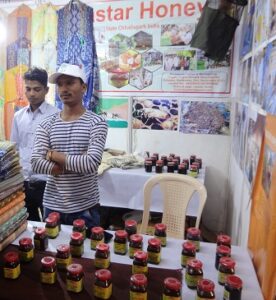 But there is good news in India for the honeybees, as governments and various organizations like KVIC try to provide a livelihood for people living in rural areas through proper training and use of Bee boxes provided to them by the concerned authorities.
But there is good news in India for the honeybees, as governments and various organizations like KVIC try to provide a livelihood for people living in rural areas through proper training and use of Bee boxes provided to them by the concerned authorities.
The Mahalaxmi SARAS2019 Fair taking place at Bandra in Mumbai is highlighting the Bees and their keepers. One of them is software engineer Suprajit Raikar and his wife Deepika (an M.Com graduate who manages the honey business accounts books)– who chose to turn bee-keepers by giving up lucrative careers –and have come here from the village of Benaulim in the tiny state of Goa to showcase their efforts in bee-keeping and honey production.
“We are highlighting two types of honey: Raw Honey, which is good for use in Ayurvedic medicines, and Filtered Honey, which is good for all especially kids less than one year old who are allergic to pollen. These honey varieties are sold at between Rs 100 to Rs 500 per bottle. Beeswax, which used to be thrown away earlier, is now used by us for ‘soap’ priced at Rs 50, and also as ‘Lip Balm’ sold for Rs 100,” said Raikar who mentioned that both of them decided to undergo one-week training at the Central Bee Research and Training Institute in Pune, before setting up their own honeybee-keeping business in their own ‘scientific’ way.
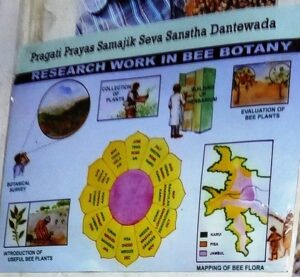 “We named our produced honey as “Sahyadri Honey” after the well-known Sahyadri Mountain ranges in the Western Ghats from where we source our bees. ‘Apis Cerena Indice’ is the name of this species of bees, which are known locally in Konkani language of Goa as “Satordem” (meaning “Seven Combs” since they produce seven honeycombs in a ‘side-by-side row’ in each of the hives.”
“We named our produced honey as “Sahyadri Honey” after the well-known Sahyadri Mountain ranges in the Western Ghats from where we source our bees. ‘Apis Cerena Indice’ is the name of this species of bees, which are known locally in Konkani language of Goa as “Satordem” (meaning “Seven Combs” since they produce seven honeycombs in a ‘side-by-side row’ in each of the hives.”
“Earlier, villagers traditionally used smoke or fire to flush out or drive away temporarily the bees from their hives before extracting the honey. But we do without this,” said Raikar who is also a resource person in the ‘Krishi Vigyan Kendra’ (Central Government Institute that is training farmers), besides also being associated with NABARD (“which has supported our participation here”), Goa Biodiversity Board, KVIB Goa and the Goa Agriculture Department.
He also revealed an interesting fact about bees. “There are also ‘stingless” species of bees which 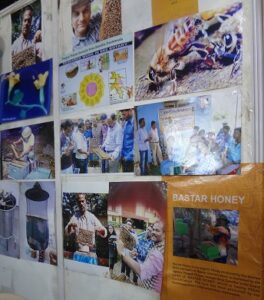 produce very little honey, but do a lot of good in other ways. Farmers buy boxes — containing entire colonies – of these bees which are then used for cross-pollination of the vegetables like cucumber, watermelon in their growth. These are the cheapest and safest species of bees that work in keeping both the concerned parties – bees and flowers — happy.”
produce very little honey, but do a lot of good in other ways. Farmers buy boxes — containing entire colonies – of these bees which are then used for cross-pollination of the vegetables like cucumber, watermelon in their growth. These are the cheapest and safest species of bees that work in keeping both the concerned parties – bees and flowers — happy.”
“When the vegetables’ flowers come out, these bees fly from one flower to another to suck the nectar and thus pollinate them. The flowers, in turn, use the cross-pollen to bear their fruits,” Raikar said while pointing out that he is participating for the first time in the Mahalaxmi SARAS Fair 2019. “Business has been nice, but I am sure the weekend will bring more visitors and buyers,” he added.
Meanwhile, from the northern region of Chhattisgarh comes Rajesh Yalam (20), who lives in Dantewada village of Bastar district and is promoting bee-keeping and honey extraction there. “Our tribal women are supported by NABARD, which supplies us beehives boxes and the local species of bees that thrive on the flowers of trees like Mahua, Banana, Tamarind, Teak and Nilgiri,” he said.
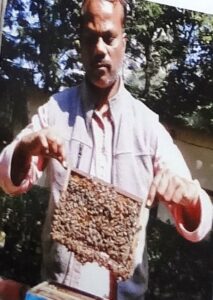 “We also use beehive boxes (costing Rs 5,000 each) that are made locally, or else we buy them from Bangalore. KVIC is also supplying us these beehive boxes but efforts in using their bees is not successful due to them being Italian species, which do not survive here because they have a preference for sucking nectar from sunflowers and are used to living in a Mediterranean climate.”
“We also use beehive boxes (costing Rs 5,000 each) that are made locally, or else we buy them from Bangalore. KVIC is also supplying us these beehive boxes but efforts in using their bees is not successful due to them being Italian species, which do not survive here because they have a preference for sucking nectar from sunflowers and are used to living in a Mediterranean climate.”
“Bastar Honey,” which is the brand name of his honey on sale at the Fair, is displayed prominently on a poster of his village which reads “Bastar Honey is the organic honey produced by the women SHG members of Bastar District, which is marketed by the agency ‘Pragati Prayas Samajik Seva Sanstha’ in the brand name of Bastar Honey, which is having FSSAI certification. The unit has been promoted by the Dantewadia District Administration, Dantewada.”
Yalam, who is also a certified trainer after being trained for one year at the Bee Research Centre in Pune, today imparts bee-keeping training to people living in 20 villages having between 3,000 to 4,000 population.


